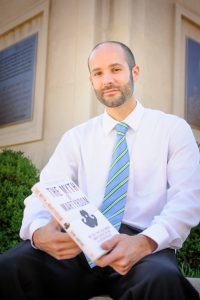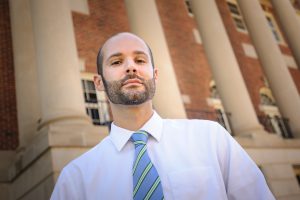Soon after the 9/11 terrorist attacks, many Americans rallied around the United States military and its retaliatory efforts across the globe.
People hung American flags outside their homes and organized send-off ceremonies for soon-to-be deployed troops. Others felt a stronger root of patriotism and opted for military enlistment.

For Dr. Adam Lankford, then a senior at Haverford College, the inspiration derived from the attacks and the subsequent 9/11 Commission Report was to understand why 9/11 happened and how to thwart suicide attacks – through psychology.
Through graduate school and his academic appointments, Lankford, now a faculty member in The University of Alabama’s criminal justice department, has authored more than a half-dozen journal articles about suicide terrorism. But, in 2010, while teaching a class on terrorism at UA, he discovered a connection that would buck the conventionality of why people carry out suicide attacks.
After showing his class videos of terrorists’ interviews, Lankford became speculative of the near universal notion that suicide terrorists, at their core, have the same motivation to defend their cause or countries as the Secret Service agent who – both willingly and proudly – takes a bullet for the president or the firefighter who runs into a burning building to save a child before perishing in flames.
“You could see things in their body language,” Lankford says of the video footage, “the way some of the terrorists would recite their rhetoric. You could tell some of them were hiding things from the person who was interviewing them.
“That’s a trait suicidal people and mass shooters share,” he adds. “Friends and family often have no idea a loved one is suicidal.”
Previous researchers had not drawn comparisons between suicide terrorists and rampage shooters, although compelling evidence indicated they should, Lankford says.
Lankford, author of “The Myth of Martyrdom: What Really Drives Suicide Bombers, Rampage Shooters, and Other Self-Destructive Killers,” released in January 2013, had collected a wealth of material about suicide terrorists years before starting research for his book.
But with a new comparative analysis between suicide terrorists and rampage shooters, he dug deeper into unclassified government reports, previously written articles, video interviews and transcripts, looking for evidence that suicide terrorists are driven by the same things that drive suicidal people: depression and hopelessness.
“I was shocked to see scholars had been all agreeing on the idea of suicide terrorists as sacrificial people and had completely rejected the idea that any of them could be suicidal,” Lankford says. “We’ve come to this odd position in our history where our scholars were essentially agreeing with terrorist leaders. Our scholars believed the rhetoric that they’re (suicide terrorists) fully committed to their cause and totally believed in their ideology.”
The idea of suicide leading to eternal damnation is a standardly held belief in Islam and other religions, but radical Islamic sects have used suicide terrorism as a loophole for people to escape shame and to achieve penance, Lankford says. Terrorists are indoctrinated, but what makes such a small number commit suicide attacks while many others live relatively normal lives? Journals and diaries of suicide terrorists revealed many of the same mental health issues that rampage shooters face, says the UA College of Arts and Sciences’ faculty member.
“There are more than 90 million people worldwide, according to surveys, who believe suicide terrorism is justified,” Lankford explains. “But only about 300 of those 90 million actually do it every year. Their commitment to ideology … that’s not enough to get someone to kill themselves. What’s different about those 300 is that something goes terribly wrong in their lives.
“One of the reasons previous scholars got it wrong,” Lankford says, “is that, in many cases, the suicide bomber lies, saying they did it for God or some other inspiration to cover up something deeper.”
Mass shooters, suicide terrorists – one and the same
Lankford says many cross-cultural comparisons can be made to prove the similarities between mass shooters and suicide terrorists.
He used the example of Seung-Hui Cho, the Virginia Tech student who killed 32 people and injured 17 others in a shooting rampage in 2007. Though Cho sent a video to news outlets claiming to be a martyr in the same mold of Jesus, an investigation following the shootings revealed he was depressed and suffered from an anxiety disorder. Cho’s comments mirror what suicide terrorists claim, Lankford says.
“A lot of times, there’s a cause and effect,” Lankford explains. “For instance, a woman who is 18 or 19 and is not married gets pregnant. That’s a major problem in the Islamic world. She’s very fearful about the consequences, and, two weeks later, this woman, who has never been involved in terrorism before, carries out a suicide bombing. It’s pretty clear that she may share some basic ideology, but she’s not a real terrorist. Something dramatic changed her life. In other cultures, it may be that a girl gets pregnant then overdoses on prescription pills. The connections between these same life stories that lead to suicide and suicide terrorism are very strong.”

Lankford also references the arrest of Shaker Masri, a Chicago man who was recently sentenced to 10 years in prison after plotting a suicide bombing overseas. Masri’s plot was foiled after he gave information to an informant, who noted Masri’s desire to join Al-Qaeda. While Masri’s story is similar to others who seek martyrdom through suicide attacks, Lankford notes Masri’s deteriorating relationship with his girlfriend, who lived in London.
“You could see, based on the conversations they had, that the thing that changed in his life is his girlfriend dumped him,” Lankford says. “They used code words about what he planned to do, but it’s pretty clear. At that point, he starts to confess about earlier life problems. FBI records quote Masri as complaining that ‘Life is not worth living for me. I cannot enjoy life. I have not enjoyed it since I was eighteen. I have not enjoyed life since I was a child. I lost that innocence.’ ”
Remaining objective, regulating emotion
Lankford drew evidence from different sources, including video transcripts, news stories and published government reports. The most interesting sources, he says, were the video interviews, where Lankford could read body language and analyze voice inflection to help identify lies and deception.
“Maintaining a distance allows you to be more objective, more scholarly,” Lankford says. “You need to be a little bit cold blooded to analyze a terrorist attack without being overwhelmed by your own emotions. Distance helps with that.”
Despite reading thousands of pages recounting mass shootings and suicide bombings, Lankford says he didn’t become desensitized to trauma, partly because he avoided photos of maimed bodies or blood spilled on streets. Distance, again, was vital to maintaining perspective while writing his book.
“If you view images every day, you lose that perspective of the person who is traumatized for the first time,” Lankford says. “My vulnerability is seeing a horrific image and having it turn my stomach. That’s what many people go through, and I’ll relate to them better.”
Aiding law enforcement
Where does a researcher fit into the complex matrix of anti-terrorism agencies? Right in the middle, says Lankford.
Whether it’s the CIA, FBI or Department of Homeland Security, missions are often narrow in scope and crafted to produce immediate results. There isn’t much time or resources for a government agent to spend analyzing the psychological factors of what’s driving suicide terrorists, Lankford says.
“It’s about priorities,” Lankford adds, “and these guys need to stop an attack tomorrow.” Still, government agencies won’t get ahead of the curve until the shot-callers recognize the suicidal traits in suicide terrorists. Seems simple, given the nature of a “suicide attack,” but, with more than 25 years of research that has led to a consensus contrary to Lankford’s findings, it won’t happen overnight.

However, the wheels are starting to turn in Lankford’s direction. He says he’s been contacted by government agencies about the information in his book, sometimes on a weekly basis. He’s done numerous interviews for print and TV news outlets, too.
“Some people have said, ‘you should come work for us,’” Lankford says. “But I don’t think that’s something I want to do. I get contacted by new people on a weekly basis, but I don’t have a sense of how it will all unravel.
“My hope is to continue to challenge the terrorist propaganda and the terrorist groups who prey on people who are already suicidal,” he adds. “If we really get the truth out there about the exploitation, terrorist organizations would actually stop the practice because it would cost them support. It would remove one of their most significant and dangerous methods of terror.”
